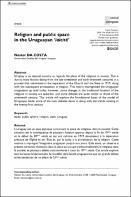JavaScript is disabled for your browser. Some features of this site may not work without it.
Religion and public space in the Uruguayan 'laïcité'
Resumen
Uruguay is an atypical country as regards the place of the religious in society. This is due to many factors dating from the late nineteenth and early twentieth centuries in a
process that culminated in the separation of the Church and the State in 1919, along with the subsequent privatization of religion. This matrix impregnated the Uruguayan
imagination up until today; however, some changes in the traditional location of the religious in society are apparent, and some debates are quite similar to those of the
nineteenth century. This article will explore the foundational bases of the model of Uruguayan laïcité, some of the main debates about it, along with the trends existing in
the twenty-first century.
Colecciones
- Artículos [51]


